 BRITAIN’S MOST FAMOUS LOUDSPEAKERSEVO4 SeriesEVO 4.1, EVO 4.2, EVO 4.3, EVO 4.4, EVO 4. C, EVO 4. CS, EVO 4.SUser Manual
BRITAIN’S MOST FAMOUS LOUDSPEAKERSEVO4 SeriesEVO 4.1, EVO 4.2, EVO 4.3, EVO 4.4, EVO 4. C, EVO 4. CS, EVO 4.SUser Manual

Important Safety Information
Before installing this product read all these instructions!



Preparing the EVO4 Loudspeakers
Stands and BracketsThe bookshelf loudspeakers are intended primarily for stand mounting, though they can be mounted on wall brackets or even on sturdy shelves. The quality of loudspeakers stands greatly influences the performance of your loudspeakers, please do nosy products.Centre Channel LoudspeakersEach center channel loudspeaker is supplied with one set of mounting feet. By using a combination of large and small feet the loudspeaker may be angled to point directly at the listening position. This will be found useful when the center speaker is positioned under the TV screen.
Cables and Connectors
Choosing Loudspeaker CableSpecialist audio cable usually o ers better performance than general-purpose ‘bell’ or ‘zip’ wire.Choose a cable of suitable diameter – a cable that is too thin will limit the dynamics of the sound and may impair the bass response. Audio cable is polarised, with two cores of di erent colors, or often a raised rib or colored tracer in the case of twin cable. Before you purchase your cable, give careful thought to the positioning of your loudspeakers.This is especially the case if you are bi-wiring your loudspeakers.Cable lengths to loudspeaker pairs should be the same for left and right channels in order to equalize the signal transmission. Allow some slack in your speaker cables so you can alter their position to the best advantage.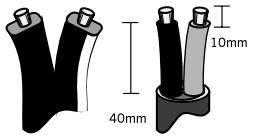

Preparing Loudspeaker Cable
Split the twin cores to a depth of about 40mm. Carefully strip the insulation from each end, leaving about 10mm of bare wire. If the cable is stranded, lightly twist to gather any loose strands.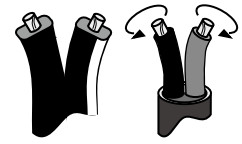

Connecting Screw Terminals
All loudspeakers use screw terminals.Unscrew the terminal. Insert the bare end of the cable into the hole in the base of the terminal. Tighten securely. When connecting terminals make sure you leave no strands of bare wire that can short across to adjacent terminals.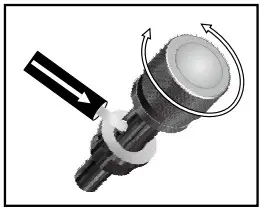

Crossover Networks
Bi-Wirable NetworksIf your speakers use a special bi-writeable crossover panel with four terminal binding posts. Please follow the drawing carefully to see the correct orientation of the loudspeaker terminals. The upper terminals connect to the treble unit, the lower pair to the bass unit. As supplied, the treble terminal pair is connected to the bass terminal pair via removable metal straps. These should be left in place for standard installations.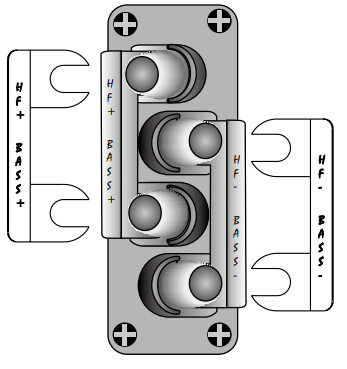



Positioning the Front Loudspeakers
The EVO4.3, EVO4.4 models are designed to be r standing. We suggest that they are positioned at least 200mm from the rear walls and 700mm from the sidewalls, facing slightly inwards. The EVO4.1 and EVO4.2 models should be stand or wall mounted though they may be placed on a rigid shelf. The bass extension will improve if the small speakers are operated closer to the rear wall.If the loudspeakers are placed too close to the walls the bass will increase but maybe boomy and indistinct. If the loudspeakers are placed away from the walls, the inward angle may be increased by up to 40%, although this may restrict the width of the optimum listening position.A useful rule of thumb is that the listener should be as for from the loudspeakers as they are from each other. The speakers should ideally be positioned so that the treble units are roughly at ear level to a seated listener. As personal taste plays a large role, experiment with di erent conrations and play a wide range of programs before of your speakers.


Positioning the Centre Loudspeaker
The center channel loudspeaker should be positioned centrally between the loudspeakers, close to the television, and mounted above or below the screen.The loudspeaker should be located on a stable surface to avoid any cabinet movement at high sound levels. If you mount the unit above the television, move it forward so that the front grille sits slightly in front of the screen and the top of the cabinet.A custom stand is available for the model which allows the loudspeaker to be positioned under a wall-mounted monitor and has an adjustable vertical tilt for optimal dispersion.
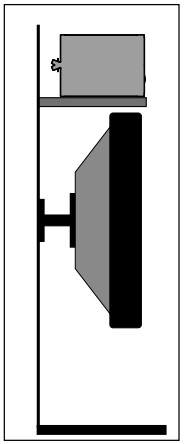  |
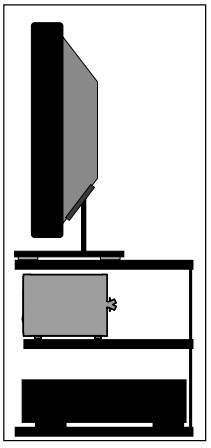  |
Positioning Surround Loudspeakers
EVO4.S Surround LoudspeakersThe speakers should ideally be sited 600 mm-1.5 meters above the listening position and 2.5-3.5 meters apart, central to the listener and behind the listening position, preferably n a rear wall. If the listening position is some distance from a rear wall, the speakers may be mounted on opposite side walls but always behind the listening position.Ensure that the wall is sound and can support the product. Drill two 5mm holes in the wall 200mm apart.Fix a suitable No 8 round head screw firmly into each hole using appropriate wall plugs. Leave a stub of 5mm protruding from the wall.Connect the loudspeakers. Align the holes in the mounting brackets over the screw and carefully lower the unit onto the screws. The speaker should now be securely attached with the spacers resting against the wall. Now connect the speakers to the amplifier.

Connecting the Front Loudspeakers
Standard ConnectionChoose a suitable length of twin core speaker cable for each channel, and prepare the ends. Unscrew each terminal a few turns.Connect the red, positive (+) terminal of the Left loudspeaker to the corresponding red, positive (+) ample er terminal. Connect the black, negative (-) terminals similarly. Tighten the terminals securely. Repeat this procedure for the Right channel.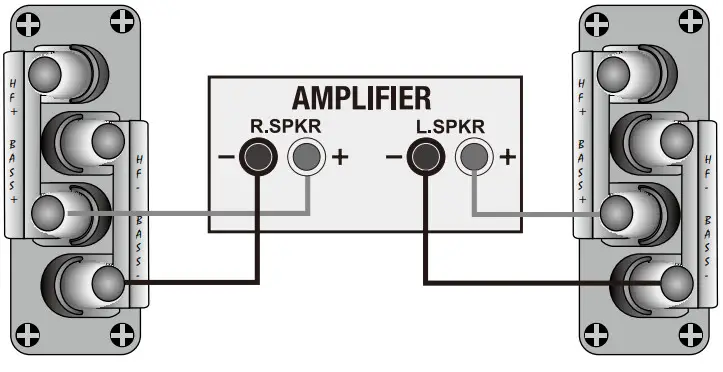

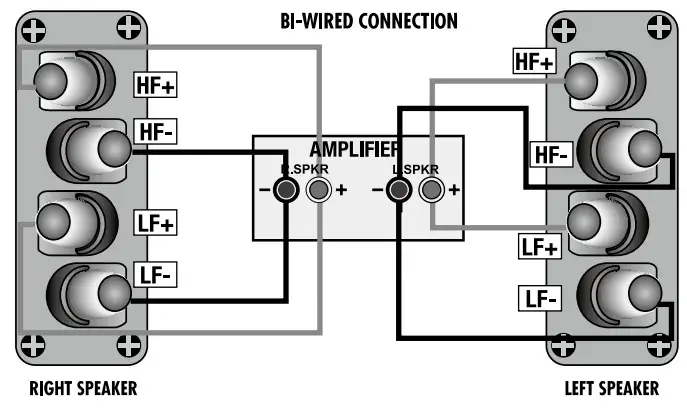

Connecting Centre Loudspeaker
The Centre channel speaker may be connected as shown, or bi-wired.
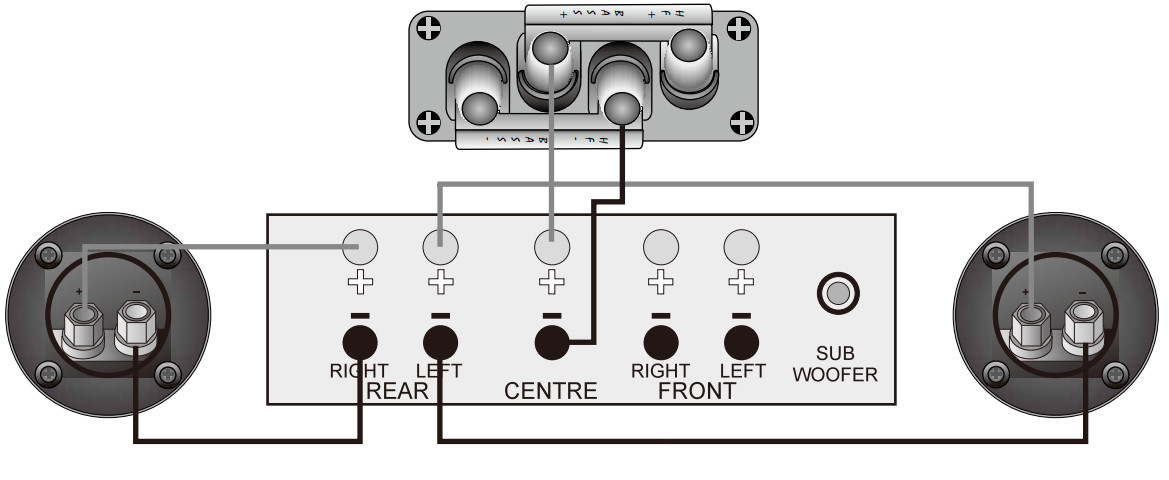

Setting Up a Home Theatre System
PlacementFront and E acts Channels: The front loudspeakers are placed on either side of the television screen, 2 to 3 meters apart. The speakers should be angled slightly so the car is aimed towards the listeners.We recommend placing the rear effects speakers in a high position, behind the listener’s head. If the rear or side walls are a long way from the listening seat, consider standing mounting the loudspeakers. If the center loudspeaker is very high or low, angle it towards the listener’s ear level.The front faces of the center and surround loudspeakers should also be in line as far as possible.Subwoofer: As the ear is unable to detect the direction from which deep bass originates, you have the freedom to position the unit. Varying the distance from the wall alters the bass. Placing the subwoofer across a corner boosts the bass but may impair clarity. The performance of a home theatre system can be enhanced by using two subwoofers.6.1 and 7.1 System PlacementDolby Labs, DTS, and THX offer 6.1 and 7.1 formats. Although the precise con duration of these systems will depend on the capabilities of your processor and you should be guided by those instructions, we would make some observations.For 6.1 and 7.1 formats the listening seat should not be too close to the rear wall.Optimizing the time delay so that information from all speakers arrives at the listening seat coherently is critical of the benefits of these systems are to be fully realized.Dolby Labs Recommended Placement for Multichannel Home Theater Systems 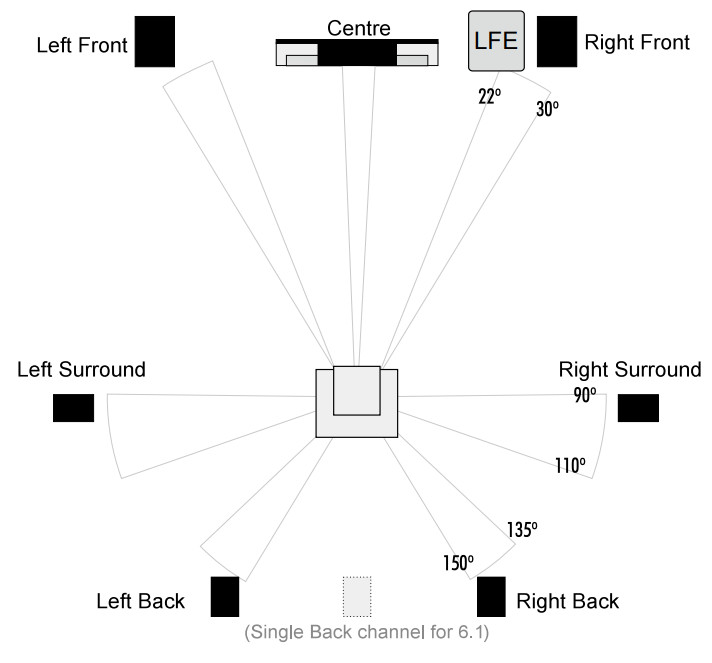

If you are not using a subwoofer: Set the Front speakers to ‘Large’. Set the ‘Subwoofer’ option on the processor to ‘ ’ or ‘No’. The Front channels will now receive all the system bass.If you are using a subwoofer: When set to ‘Small’ all the system bass will go into the subwoofer. If you choose ‘Large’ the Front channel bass will be reproduced from the Front speakers. Follow the instructions on this page for suitable size and crossover settings.Once the loudspeaker settings have been put the A/V r into its ‘Test’ mode (see instructions supplied with your processor). Adjust the level of each channel until all channels are reproduced at equal loudness.On some program material, the surround channel may seem lower in level than the front. Do not readjust this level. You may, however, need to adjust the subwoofer output level. Avoid setting too high a level or you will swamp the sound with bass. This can be tiring to listen to and may limit the subwoofer’s ability to respond to large bass transients. You should also set a sensible level going into the subwoofer from the A/V processor. Start with the subwoofer volume control set to between 12 o’clock and 3 o’clock.
Delay and LFE Settings
Many A/V processors feature delay settings. The purpose of the delay is to enable surround and dialogue information to arrive at the listener’s ears at the same time as the front channels, even when the listening seat is in a non-ideal position. On some processors, this can be achieved by setting the distance from the listening position to each speaker, but other systems allow only a time delay setting.Rear Delay: If the listening position is equidistant from the front and rear speakers, set a low delay setting. The closer the listener is to the rear speakers the higher the delay setting used should be.Centre Delay: If the center speaker is level with (or slightly behind) the front speakers, set the delay to zero. If the center speaker is forward of the front speakers, increase the delay.LFE: In the cinema, the low-frequency effects channel is an extra bass channel with its own subwoofer. In domestic systems, the LFE channel typically feeds into the subwoofer. Where no subwoofer is used, the LFE signal is combined with the front channels and sent to the front speakers. When you set the LFE level at your A/V processor, use care as powerful low frequencies can overload domestic loudspeakers. If you hear popping or thumping noises coming from the front loudspeakers or subwoofer, immediately turn the A/V processor’s volume level down and then lower the LFE level. This should cure the problem. If it does not, lower the volume level at the subwoofer (if you are using one) until the problem disappears.Phase: Please read the relevant sections of your A/V ar manual and familiarise yourself with the various issues. If you are unsure, consult your dealer for help. A home theatre system should have a precise front stage, a d used the rear stage and good localization of dialogue. If the colors on the loudspeaker terminals do not correspond with those on the r, the sound will appear poorly focused or ‘out of phase’. For this reason, it is essential that the speakers are connected according to the wiring diagrams in this manual.Connecting loudspeakers correctly (in-phase) is essential whether the system is stereo or multichannel. This is especially important if you are bi-wiring – if only one element in a bi-wired system is incorrectly connected (out of phase), the effects can be very noticeable yet hard to pinpoint.
Troubleshooting
Before investigating a problem, always switch o the system at mains.If your system is not working properly please work through this checklist before returning the unit to your dealer.
| Symptom | Possible Cause |
| No Sound | The system is not switched on: Speaker cables shorting terminals out: The wrong source selected |
| Sound lacks bass content | The subwoofer is not switched on |
| Lack of bass reproduction | Subwoofer phase incorrect: Subwoofer crossover control too low |
| Excessive bass distortion at two volumes | Subwoofer set to high: LFE level set too high: Subwoofer incorrectly wired |
| Excessive or distorted bass at high levels | System-level set too high: Bass control set too high: Subwoofer too close to room corners |
| Distorted / rattling sound at high levels | System-level set too high: Objects too close to subwoofer |
| Popping or thumping from the subwoofer | System-Level set too high: Subwoofer level set too high: LFE level set too high |
Looking After Your Loudspeaker
- This speaker is finished with a luxurious real wood veneer. As with all real wood furniture finishes exposed to direct sunlight heat. cold and varying humidity can affect the natural properties of the real wood We advise protecting the speaker from extreme variances in temperate and environmental conditions.
- We advise that you do not place anything on the surface of the cabinets, to protect from damage. Treated with cart the real wood veneers wig last a lifetime. They wig age naturally and subtly. retaining the properties of the beautiful wood finish.
- Your loudspeakers use a special hardwearing seated finish They should not be waxed or treated with Spray polishes attach will smear and dim the finish. Occasionally polish them with a dry or barely moist cloth to remove dust and finger marks. etc.
- If you play the speakers with the grilles off exercise great care NEVER operate speakers with the grilles if there are children or pets in the house.
- Occasionally, remove the loudspeaker grilles and brush them gently with a soil brush before replacing them carefully.
- We advise that you do not use a vacuum cleaner to clean loudspeakers
- We advise that you do not place anything on your loudspeakers to prevent damage to the cabinet surface.
- Avoid getting any liquid behind the grille If you spat liquid on your loudspeakers. take them to your dealer for attention before using them again.
- DO NOT open the speakers. there are no user-serviceable parts inside.
- NEVER touch the drive units Other with an object or your hands.
Quality Assurance
Your loudspeakers have been constructed to the highest standards From top-grade furniture construction and finish to carefully designed and selected acoustic components. Wharfedale speakers we but to provide a Lifetime of sonic pleasure. We hope you will derive many years of good service from our products.ServicingIn the unlikely event that your unit develops a fault, you should return it to your Wharfedale dealer using the original packing to ensure safe shipping.The terms of your guarantee may vary in different countries. However. in all cases the guarantee excludes Liability for damage or loss occurring in transit to or from the purchaser.All damage is caused by an accident. misuse. wear and tear. neglect incorrect installation. adjustment or repair by unauthorized personnel Wharfedale will not be liable for any consequential damage. loss or injury. arising from or in conjunction with this equipment.Service Centre AddressFor technical support. servicing or product queries and information please contact either your local retailer or the office below.UKIAG Service Dept 13/14 Glebe Road HuntingdonCambridgeshire PE29 7DLUKTel .44(01480 45TheaEml: [email protected]For information on other authorized service centers worldwide contact Wharfedale International. The UK.A Worldwide distributors list is available on the Wharfedale website www.Warfedate.co.uk
Specifications
  |
  |
  |
  |
|
| Model | EVO 4.1 | EVO 4.2 | EVO 4.3 | EVO 4.4 |
| General Description | 2-way bookshelf speaker | 3-way bookshelf speaker | 3-way floor standing speaker | 3-way floor standing speaker |
| Enclosure Type | bass-reflex | bass-reflex | bass-reflex | bass-reflex |
| Transducer Complement | 2-way | 3-way | 3-way | 3-way |
| Bass Driver | 5(13ornm) black woven Kevtar® cone | 6.5′(165mm) black woven Kevlar® cone | 5′(13omm) black woven Kevlar® cone x2 | 6.5(165mm) black woven Kevlar® cone x 2 |
| Midrange Driver | — | 2′(50mm) soft dome | 2″(50mm) soft dome | 2′(50mm) soft dome |
| Treble Driver | 30’6omm AMT | 3otomm AMT | 3o’60mm AMT | 3otomm AMT |
| AV Shield | No | No | No | No |
| Sensitivity (2.83V ® iM) | 87dB | 87dB | 88dB | 8gdB |
| Recommended Amplifier Power | 25-100W | 25-120W | 25-150W | 30-200W |
| Peak SPL | 104dB | 1o5dB | 105dB | 107cIB |
| Nominal Impedance | 80 compatible | 80 compatible | 80 compatible | 80 compatible |
| Minimum Impedance | 3.50 | 4.00 | 440 | 4.30 |
| Frequency Response (+/-3dB) | 641-1z – 22kHz | 54Hz – 22kHz | 48Hz – 22kHz | 44Hz – 22kHz |
| Bass Extension (-6dB) | 55Hz | 48Hz | 42Hz | 38Hz |
| Crossover Frequency | 2.9kHz | 1.4kHz.3.9kHz | 1.3kHz.4.3kHz | 1.4kHz.4.7kHz |
| Dimensions (1-IxWxD) | 335 x 210 x (285+10)MM | 455 x 250 x (340+10)MM | 875 x 210 x (285+10)Min | 1060 x 250 x (340+10)mm |
| Net Weight | 7.8kg/pcs | 13.4kg/pcs | 22.8kg/pcs | 25.6kg/pcs |
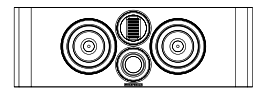  |
  |
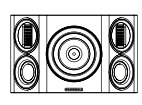  |
|
| Model | EVO 4.0 | EVO 4. CS | EVO 4.S |
| General Description | 3-way center speaker | 2-way center speaker | 3-way surround speaker |
| Enclosure Type | bass-reflex | bass-reflex | dosed box |
| Transducer Complement | 3-way | 2-way | 3-way |
| Bass Driver | 6.5%165mm) black woven Kevlar® cone x 2 | 5%130mm) black woven Kevlar® cone x 2 | 6.5%165mm) black woven Kevlar® cone |
| Midrange Driver | 2-(50mm) soft dome | 2%5Omm) soft dome x 2 | |
| Treble Driver | 3o’6omm AMT | 30’60mm AMT | 30’60mm AMT x2 |
| AV Shield | No | No | No |
| Sensitivity (2.83V 0 1M) | god | 8gdB | 88dB |
| Recommended Amplifier Power | 25-150W | 25-100W | 25-120W |
| Peak SPL | 108dB | 103dB | 1o6dB |
| Nominal Impedance | 80 compatible | 80 compatible | 80 compatible |
| Minimum Impedance | 4.30 | 4.40 | 3.90 |
| Frequency Response (+/-3dB) | 48Hz – 22kHz | 50Hz – 22kHz | 70Hz – 22kHz |
| Bass Extension (-6dB) | 42Hz | 45Hz | 65Hz |
| Crossover Frequency | 1.5kHz.3.9kHz | 2.7kHz | 1.5kHz. 4.4kHz |
| Dimensions (HxWxD) | 245 x 750 x (340+10)mm | 185 x 585 x (265+10)mm | 245 x 400 x (1.45+10)rnm |
| Net Weight | 15.8kg/pcs– | n.6kg/pcs– | 11.8kg/pcs |



IAG House, 13/14 Glebe Road, Huntingdon, Cambridgeshire, PE29 7DL, UKTel: +44(0)1480 452561 Email: [email protected] http://www.wharfedale.co.ukIAG reserves the right to alter the design and specifications without notice. All rights reserved IAG Group Ltd.Wharfedale is a member of the International Audio Group.
References
[xyz-ips snippet=”download-snippet”]

